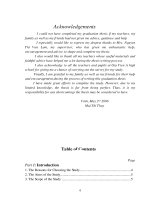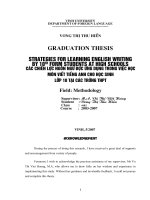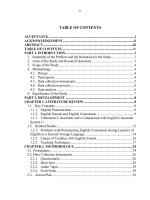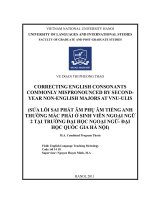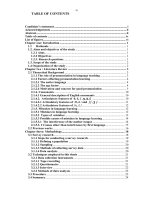correcting english consonants commonly mispronounced by second-year non-english majors at ulis_vnuh = sửa các lỗi sai phát âm phụ âm tiếng anh thường mắc phải ở sinh viên ngoại ngữ tại trường đại học ngoại ngữ
Bạn đang xem bản rút gọn của tài liệu. Xem và tải ngay bản đầy đủ của tài liệu tại đây (1.13 MB, 88 trang )
iv
TABLE OF CONTENTS
ACCEPTANCE i
ACKNOWLEDGEMENT ii
ABSTRACT iii
TABLE OF CONTENTS iv
PART I. INTRODUCTION 1
1. Statement of the Problem and the Rationale for the Study 1
2. Aims of the Study and Research Questions 3
3. Scope of the Study 4
4. Methodology 4
4.1. Design 4
4.2. Participants 4
4.3. Data collection instruments 5
4.4. Data collection process 6
4.5. Data analysis 6
5. Significance of the Study 7
PART 2. DEVELOPMENT 8
CHAPTER 1. LITERATURE REVIEW 8
1.1. Key Concepts 8
1.1.1. English Pronunciation 8
1.1.2. English Sounds and English Consonants 9
1.1.3. Vietnamese Consonants and a Comparison with English Consonant
System 11
1.2. Related Studies 13
1.2.1. Problems with Pronouncing English Consonants among Learners of
English as a Second/ Foreign Language 14
1.2.2. Causes of Troubles with English Sounds 16
1.2.3. Teaching Techniques 17
CHAPTER 2. METHODOLOGY 24
2.1. Participants 24
2.2. Data Collection Instruments 26
2.2.1. Questionnaire 26
2.2.2. Interviews 28
2.2.3. Audio Tapes 29
2.2.4. Field Notes 29
2.3. Action Plan 30
v
2.3.1. Material 32
2.3.2. Research plan 33
CHAPTER 3. RESULTS AND DISCUSSION 38
3.1. Research Question 1. What are English consonants that are often
mispronounced by non-English majors? 38
3.2. Research Question 2. What are the reasons for the students’ problems of
pronunciation? 42
3.2.1. Inadequate exposure to English language 42
3.2.2. Inadequate understanding of English sounds 43
3.2.3. Influence of mother tongue 44
3.2.4. Influence of first foreign language, i.e. major 45
3.2.5. Influence of hometown dialects 46
3.2.6. Hesitation to express oneself 47
3.2.7. Other reasons 47
3.3. Research Question 3. What are the appropriate techniques employed? 51
3.3.1. Phonemic chart, Sound description 51
3.3.2. Minimal pairs 53
3.3.3. Tongue twisters 54
3.3.4. Comparing students’ speech with the model 55
3.3.5. Games 56
3.3.6. Continuous feedback 56
3.4. Research Question 4. What are students’ remaining problems in terms of
pronunciation of English consonants after the project? What are possible
reasons? 57
PART III. CONCLUSION 64
1. Major Findings of the Study 64
2. Limitations of the Study 67
3. Suggestions for Further Research 68
4. Recommendations 69
REFERENCE 71
APPENDICES I
APPENDIX 1 I
APPENDIX 2 II
APPENDIX 3 IV
APPENDIX 4. V
APPENDIX 5 VII
vi
LIST OF TABLES, FIGURES AND ABBREVIATION
TABLES
Table 1: Classification of English consonants
Table 2: Vietnamese initial consonants
Table 3. Vietnamese final consonants
Table 4. Classification of participants basing on gender and time learning
English
Table 5. Research program – action plan
Table 6. Students’ problems of English consonants at the beginning of the
project
Table 7. Problems of consonants by students in group mini-presentation
Table 8. Problems of consonants by students in voice recordings
Table 9. students’ problems of consonant pronunciation at final process
FIGURES
Figure 1: Features of pronunciation
Figure 2: Stern’s range of procedures for teaching pronunciation
Figure 3. Action research cycle
vii
CHARTS
Chart 1. Possible reasons for students’ problems of English consonants
ABBREVIATIONS
VNU-ULIS: University of Languages and International Studies – Vietnam
National University, Hanoi
1
PART I. INTRODUCTION
This initial part serves stating the problem and the rationale for the study,
as well as the aims, objectives, design and the scope of the whole paper. Above
all, it is in this chapter that the research questions are identified to work as clear
guidelines for the whole research.
1. Statement of the Problem and the Rationale for the Study
The essentiality of teaching and learning the pronunciation of a language
has been proved by many researchers in the world. Setter and Jenkins (2005: 3)
did show the significance of the ability to communicate orally in English. In
other words, it is the key factor to maintain successful oral communication.
Speaking such an international language, effective communicators of English,
especially non-natives need to have an acceptable pronunciation. Therefore,
learning pronunciation is of significance in English study for learners of English
as a foreign language (EFL learners).
In University of Languages and International Studies, Vietnam National
University Hanoi (VNU-ULIS), English has been taught in all faculties. It is the
major of students of Faculty of English Language Teaching Education. Other
students learn English as their second foreign language. The latter group are
addressed non-English majors in this study. They spend four semesters, from the
fourth to the seventh ones, officially learning English at university. The current
study take non-English majors in their first semester, who are assumed at
elementary level as its subjects.
2
Despite its significance to the successful learning of English,
pronunciation has not been paid enough attention considering its proportion in
the syllabus of non-English majors at VNU-ULIS. With 4 or 3 credits (for non-
English majors at their first and later terms respectively), those students are
required to cover all four skills. The limitation of time is a challenge to ensure
students’ improvement in pronunciation as it is not a separate skill or subject. As
an important condition to the proficiency of listening and speaking skills (Setter
and Jenkins, 2005: 1), it is believed that pronunciation deserves to receive more
emphasis in the syllabus of non-English majors.
English pronunciation is divided into two main aspects: segmental and
suprasemental. (Roach: 2000, Cruttenden: 2001) The former, also called sounds
or phonemes, forms different segments of words. The modification of one sound
may alter word meaning and consequently influence the meaning of the whole
utterance or discourse. Moreover, a consistent mispronunciation of a range of
phonemes may be the failure to the intelligibility of the speech especially when
both listeners and speakers are not native speakers. (Kelly, 2003: 11)
Considering their basic but undeniable role in teaching and learning English
pronunciation, sounds are in focus of the study.
Despite its importance to enhance learners’ communicative competence,
teaching and learning pronunciation has never been an easy task. It is even “the
most difficult aspect” of second language as stated by Setter and Jenkins. (2005:
1) In regard with such a complex issue, particularly English sounds, a great deal
of research has been done to identify learners’ pronunciation problems and their
reasons. (see Chan & Li, 2000, Nguyen, 2005, Walker, 2000, Kenworthy, 1988)
Research on techniques and activities to facilitate teaching and learning has been
3
also a field of interest to many researchers. (see Kelly, 2003, To, 2006). Fraser
(2001) suggested not only approach but also specific techniques to teach
pronunciation at various students’ levels while Hancock (2000) provided games
that can be integrated in class to boost students’ understanding and performance.
However, as mentioned previously, little research has been conducted in the field
teaching pronunciation of sounds to non-English majors at VNU-ULIS. Hence,
there exists a gap which the current research is aimed at bridging.
2. Aims of the Study and Research Questions
The project will be carried out to reach the following aims. Firstly, the
researcher will attempt to set an overview of the research subjects by detecting
English sounds which are frequently mispronounced by many of the student
participants. This part of the study can enrich the abundant research on ESL
learners’ problems of pronunciation (Chan & Li, 200, Nguyen, 2005, Sang,
2007, Vu, 2008). Secondly, the factors that caused the problems will be
identified, so that possible techniques to solve the problems will be proposed.
Finally, students’ progress after the project will be assessed. 18 students of
Chinese Faculty will be involved in the research as participants.
The study will, therefore, answer four questions below:
1. What are English consonants that are often mispronounced by non-
English majors?
2. What are the reasons for the students’ problems of pronunciation?
3. What are appropriate techniques to correct the problems?
4
4. What are students’ improvements in terms of pronunciation of
English consonants after the project?
3. Scope of the Study
As stated above, the research will focus on non-English majors from
different faculties at VNU-ULIS in their third semester when they begin learning
the language formally at university. Those students at their first English term are
chosen because it is believed that any help given at their beginning period may
have better effect later on. Certain teaching techniques related to pronunciation
training will be studied and discussed to find out the suitable ones. The treatment
will be conducted on the subjects during 10 weeks’ time of the semester.
4. Methodology
4.1. Design
To identify non-English majors’ problems with English consonants, their
causes, effective techniques for pronunciation teaching, an action research will
be carried out.
4.2. Participants
The participants of the current research will consist of 18 non-English
majors at VNU-ULIS. To be specific, they are second-year students whose major
is Chinese.
5
4.3. Data collection instruments
In order to address three research questions, field notes, audio tapes,
questionnaires and semi-interviews will be used as the data collection methods.
Field notes will be employed by the teacher researcher in every session of
the research project to detect students’ errors of English sounds as well as
judging the effectiveness of teaching techniques applied in class.
At the first week of the research project, questionnaires will be conducted
on the students to collect students’ personal information that is useful for
considering their pronunciation ability as well as Moreover, it is used find out
those students’ opinions on the reasons for their mispronunciation.
Semi-structured interviews will be conducted in front of the whole
research group in the third, the ninth and the fifteenth weeks of the semester
The information will be employed to clarify that collected from questionnaires if
necessary and seek for deeper responses.
Audio tapes will be used as a means of assessing students’ pronunciation
ability through their voice recordings prepared at home. These data will be
collected in weeks 7 and 13 of the semester.
Details about the above research methods will be discussed in the third
chapter, named Methodology.
6
4.4. Data collection process
Data from field notes and journals will be keep during all 10 weeks so that
the state and changes of the class can be well followed. Whereas, those from
questionnaire, audio tapes and interviews will be collected at the specific time
mentioned above.
4.5. Data analysis
The data collected will be categorized and serve answering each research
question as follows:
Research question 1: data from teacher’s field notes in the second week
and in the following one will be analyzed to clarify problems of pronunciation
and their causes. Those pieces of information will then be classified into smaller
hierarchies of segmental aspect in English pronunciation.
Research question 2: the analysis of data through interviews and
questionnaires will help find out the causes of students’ pronunciation problems.
Research question 3: the effectiveness of teaching and correcting
techniques will be judged during the whole process. Then the ones which work
well on the student participants will be chosen.
Research question 4. Teachers’ field notes on mini-presentations in the
last week and during the research project as well as the students recordings in
week 13 will be the answer to the last question
7
5. Significance of the Study
Once completed, the project will serve as part of continuous research on
the teaching of pronunciation for non-English majors at ULIS - VNUH.
Firstly, the participant students will experience helpful activities and thus
improve their pronunciation of English consonants. Secondly, the results of the
study will be a reference to teachers of English while they work on this part of
pronunciation training.
In this first chapter, the researcher has discussed the following points:
(a) Statement of the problem and the rationale for the study
(b) Aims and objectives of the study
(c) Scope of the study
(d) Methods of the study
(e) Significance of the study
These issues have not only justified the major contents and structures of
the study but will also work as the guidelines for the rest of the paper.
8
PART 2. DEVELOPMENT
CHAPTER 1. LITERATURE REVIEW
In this chapter, the literature on the current research will be discussed
concerning background and related studies. It begins with the key concepts of
English pronunciation and sound and a comparison with that of Vietnamese.
Then an overview of related studies will serve revealing the research gap and
justifying the aims and objectives of the present paper.
1.1. Key Concepts
1.1.1. English Pronunciation
Though reaching a general agreement on the significance of pronunciation
in second or foreign language learning, researchers have not come to a consensus
about its definition.
According to Daniel Jones (1998:5), pronunciation refers to the way
people pronounce words, which narrows down its scope to word-level. Murphy
(2003 cited in To, et al., 2006) discussed the term in view of hearers’ perception
of the information conveyed through speakers’ pronouncing of not only “words”
but also “phrases and sentences”. In other words, he emphasized on message-
transferring function of pronunciation. However, this is still too general a
definition. Setter and Jenkins (2005: 1) provides readers with a clear view of the
issue:
“Pronunciation involves the production and perception of segmentals
(sounds), both alone and in the stream of speech, where they undergo number of
9
modifications and interact with suprasegmental (prosodic) features, particularly
stress and intonation”
The researcher is in favor of the last definition for its inclusion of all the
aspects that are universally accepted in the pronunciation of a language. Details
are presented in figure 1 below.
(adapted from Kelly, 2000)
Figure 1: Features of pronunciation
1.1.2. English Sounds and English Consonants
Among the two major features of pronunciation, the current study
concerns with only sounds (or phonemes). Phonemes are the smallest units of
sounds which distinguish two words. English has 44 phonemes, 24 consonants
and 20 vowels (see Jones, 1998, Roach, 2000, Cruttenden, 2001).
10
Despite being a debatable issue, a distinction between consonantal and
vowel phonemes is of significance concerning the current study. It is common to
distinguishing them according to their production, which is partly agreed by
Hancock (1995), Cruttenden (2001) and Jones (1998). Regarding such a
criterion, vowels are those sounds that are production without any obstruction to
the flow of air from the larynx to the lips; the other sounds are named
consonants. (Roach, 2000: 10). In an attempt to define the two terms, Cruttenden
(2001) emphasized the central position in syllables of vowels and the utterance at
syllable edges of their counterparts. Based on the combination of ways discussed
above, /w, j/ are semi-vowels despite their vowel-like production.
English consonants were categorized according to their manner, place of
articulation and voicing, which is illustrated as in table 1 below.
11
Manner of
articulation
Place of articulation
Bilabial
Labio
dental
Dental
Alveolar
Post-
alveolar
Palato-
alveolar
Palatal
Velar
Glottal
Plosive
+
-
+
-
+
-
Fricative
+
-
+
-
+
-
+
-
-
Affricative
+
-
Nasal
+
+
+
Lateral
+
Approximant
+
+
+
+ : voiced - : unvoiced
(adapted from Cruttenden, 2001)
Table 1: Classification of English consonants
1.1.3. Vietnamese Consonants and a Comparison with English Consonant
System
A comparison between English and Vietnamese consonant systems can
help identify items that the two languages do not share, which could be a major
cause of students’ mispronunciation as shown by Dr. Duong Thi Nu (2009).
Therefore, the classification of Vietnamese consonants are provided here for this
purpose.

